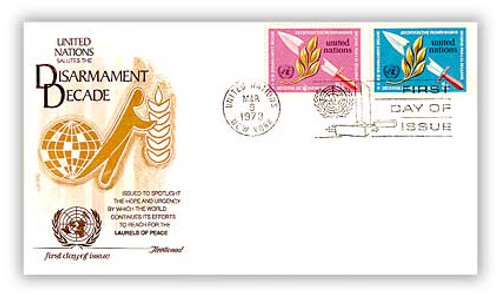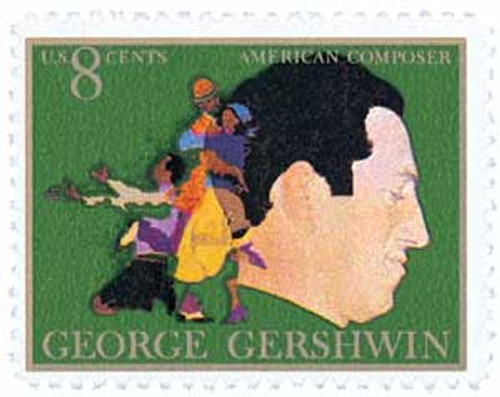
# 1504c - 1973 8c Angus Cattle
U.S. #1504c Tagging Omitted
8¢ Angus Cattle
Rural America Issue
Issue Date: October 5, 1973
City: St. Joseph, MO
Printed By: Bureau of Engraving and Printing
Printing Method: Lithographed, engraved
Perforations: 11
Color: Multicolored
Issued as part of a series honoring America's rural life, this stamp marks the 100th anniversary of the arrival of Scottish Black Angus cattle to the United States.
Angus cattle are a breed of black, hornless beef cattle that originated in Scotland. George Grant brought four Angus bulls from Scotland and transported them to his ranch on the Kansas prairie in 1873. When two of them were exhibited at the Kansas City Livestock Expo, some farmers thought they were “freaks” because of their hornless heads.
Grant crossbred the bulls with native Texas longhorn cows to produce hornless black calves that wintered well on the prairie. Others noticed the quality of Grant’s herd and began their own. Between 1878 and 1883, 1,200 more Angus were imported from Scotland.
Now you can own this stamp with rare tagging omitted. Did you know a stamp missing its phosphorescent tagging is considered by many to be similar to a missing color error? The good news is that unlike some error stamps, untagged error stamps are affordable.
What is Phosphorescent Tagging and Why is it Important?
Tagging of U.S. stamps was introduced in 1963 with airmail stamp #C64a. It helps the U.S. Post Office use automation to move the mail at a lower cost. A virtually invisible phosphorescent material is applied either to stamp ink or paper, or to stamps after printing. This “taggant” causes each one to glow in shades of green (red on older airmails) for a moment after exposure to short-wave ultraviolet (UV) light. The afterglow makes it possible for facing-canceling machines to locate the stamp on the mail piece, and properly position it for automated cancellation and sorting.
Some stamps have been printed with and without tagging intentionally, but when tagging is omitted by accident, we collectors are treated to a scarce modern color error. Our stamp experts examined thousands of stamps to find these just for you. Now you can easily give your error collection a boost or explore this fascinating new area of collecting. Quantities are limited, so order your untagged error stamp right away.
And find more tagging omitted stamps here.
U.S. #1504c Tagging Omitted
8¢ Angus Cattle
Rural America Issue
Issue Date: October 5, 1973
City: St. Joseph, MO
Printed By: Bureau of Engraving and Printing
Printing Method: Lithographed, engraved
Perforations: 11
Color: Multicolored
Issued as part of a series honoring America's rural life, this stamp marks the 100th anniversary of the arrival of Scottish Black Angus cattle to the United States.
Angus cattle are a breed of black, hornless beef cattle that originated in Scotland. George Grant brought four Angus bulls from Scotland and transported them to his ranch on the Kansas prairie in 1873. When two of them were exhibited at the Kansas City Livestock Expo, some farmers thought they were “freaks” because of their hornless heads.
Grant crossbred the bulls with native Texas longhorn cows to produce hornless black calves that wintered well on the prairie. Others noticed the quality of Grant’s herd and began their own. Between 1878 and 1883, 1,200 more Angus were imported from Scotland.
Now you can own this stamp with rare tagging omitted. Did you know a stamp missing its phosphorescent tagging is considered by many to be similar to a missing color error? The good news is that unlike some error stamps, untagged error stamps are affordable.
What is Phosphorescent Tagging and Why is it Important?
Tagging of U.S. stamps was introduced in 1963 with airmail stamp #C64a. It helps the U.S. Post Office use automation to move the mail at a lower cost. A virtually invisible phosphorescent material is applied either to stamp ink or paper, or to stamps after printing. This “taggant” causes each one to glow in shades of green (red on older airmails) for a moment after exposure to short-wave ultraviolet (UV) light. The afterglow makes it possible for facing-canceling machines to locate the stamp on the mail piece, and properly position it for automated cancellation and sorting.
Some stamps have been printed with and without tagging intentionally, but when tagging is omitted by accident, we collectors are treated to a scarce modern color error. Our stamp experts examined thousands of stamps to find these just for you. Now you can easily give your error collection a boost or explore this fascinating new area of collecting. Quantities are limited, so order your untagged error stamp right away.
And find more tagging omitted stamps here.











